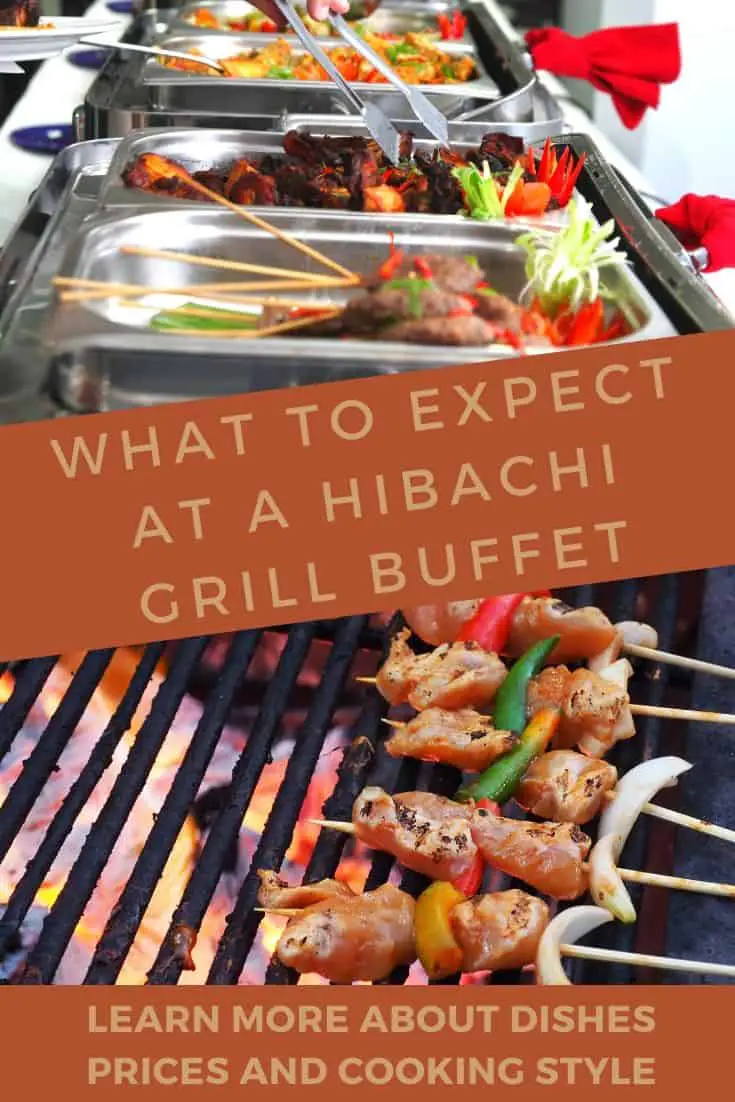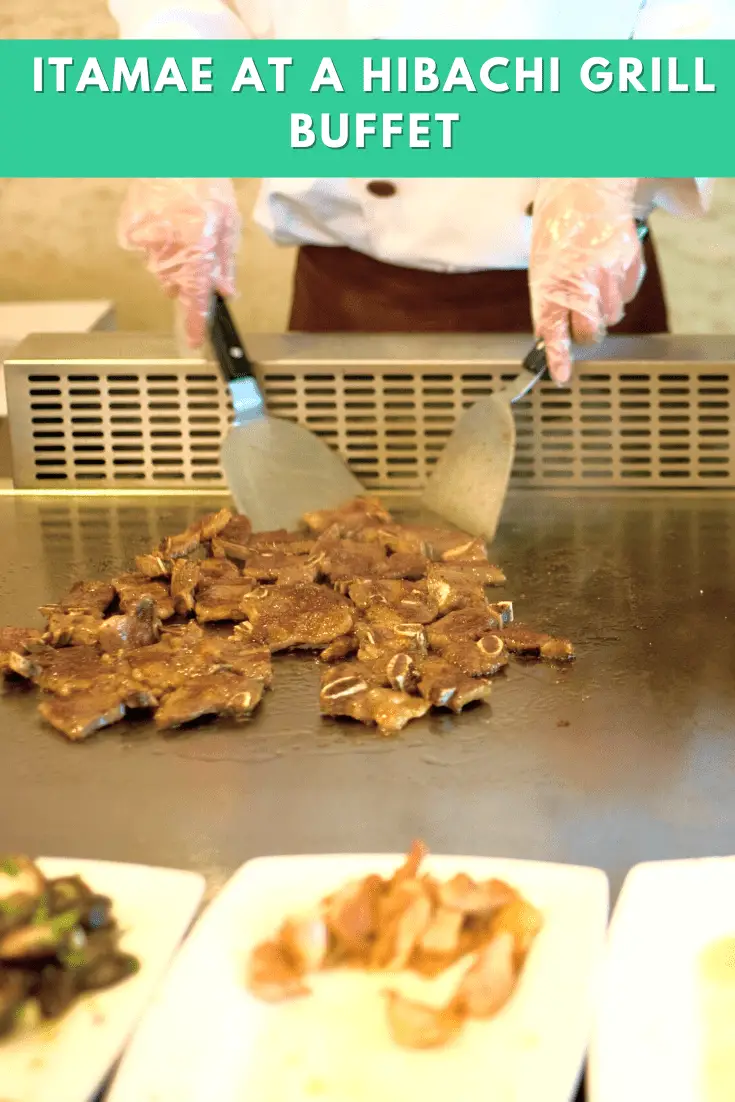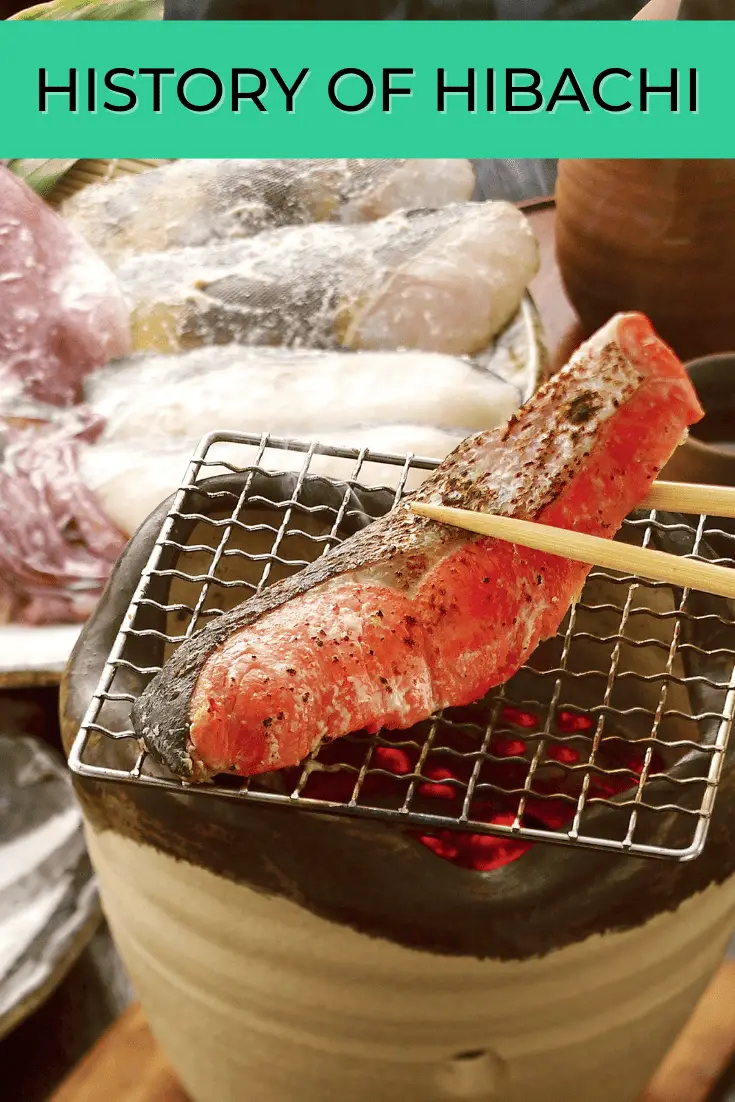What is a hibachi grill buffet? + what to expect (prices, dishes)
Hibachi buffet—this might sound like some strange kind of all-you-can-eat experience, but it’s really not as weird as you think.
A hibachi grill buffet refers to a restaurant experience where the diners sit and watch the chef cook the meals on an open fire grill. Customers are free to take any kind of food and however much they want to take too.
This delicious dining experience originated in Japan. But nowadays, you can also get it in the US.
Some people confuse it with teppanyaki, but these two are, in fact, different.
Let’s look at what to expect at a hibachi grill buffet.

If Japan is too far away, you can find some restaurants in the US that offer a hibachi grill buffet experience. You can also buy the utensils and make your family buffet at home.

Check out our new cookbook
Bitemybun's family recipes with complete meal planner and recipe guide.
Try it out for free with Kindle Unlimited:
Read for freeIn this post we'll cover:
What is hibachi?
The word “hibachi” in Japan means “fire bowl”. It refers to a grilling device with a round container.
An open grate sits at the top of the container where you put the food on for grilling. The fire bowl itself is cast iron, while the outer container can either be wood or ceramic.
Hibachi is small in size, making it portable and easy to store within the house.
Hibachi grill buffet refers to fancy dining with hibachi-style grilling where you have wide varieties of food to eat. Many kinds of meats, vegetables, and even side dishes are present.
You’re free to eat as much as you can. The chef will be grilling the food right in front of you.
There will be some amazing grilling tricks to entertain you while waiting for your meal to be ready!
The chef who cooks at a hibachi grill buffet is called “itamae”, which literally means “in front of the board”. The name refers to the chef’s position.

In the US, it’s a common misconception that the words “hibachi” and “teppanyaki” are the same. So if you find a hibachi restaurant, chances are, it has teppanyaki dining instead of an open-grate charcoal-based grilling.
Sometimes, a restaurant offers both teppanyaki-style and hibachi-style dining, allowing guests to choose one.
I’ve laid out all of the exact differences between hibachi and teppanyaki here if you’d like to dive more into that, but here, I’ll focus on the hibachi buffet.
Inside a hibachi restaurant, you’ll see large arrays of food. Any kind of food you can imagine would be there!
All are neatly organized based on the categories.
In the carbs section, you’ll see rice, bread, and various kinds of noodles such as ramen, udon, and vermicelli. In the protein section, you can name any meats you want, even the special cuts like sirloin, short ribs, etc.
Even vegans would be glad by the abundant choices of vegetables and fruits. Condiments, side dishes, and even desserts are present too.
And the food stocks aren’t only Japanese. There are also plenty of choices of food from other countries like China and Korea.
Even American food like pizza and barbecue steaks will be there as well to cater to people who want to have the experience but aren’t fans of Japanese cuisine.
If you’re interested in seeing what a hibachi grill buffet looks like, YouTube user Joane Arlene gives a great tour of one:
How to do a hibachi grill buffet
If you plan to try out a hibachi grill buffet, make sure you have a lot of time on your hands.
It isn’t fast food. Instead, it’s quite a slow dining experience where you can pick and choose, and go for a fresh plate multiple times.
You’re often free to customize your menu and ask the itamae to cook for you. The chef will ask you what kind of sauces you want as seasonings.
To make the best of your experience, the itamae will show off some of their best cooking tricks, such as tossing a shrimp up high to flip it on the grill or creating a dramatic flambe.
If you love alcoholic beverages to accompany you on a big meal, you can order some. Every hibachi restaurant provides sake of various types.
There are other kinds of boozes too, of course. But most people would order sake to complete their lavish Japanese dining experience.
After you’re done with your meal, you can move on to choose desserts to end your sophisticated meal time.
Prices
You might think that fancy buffet dining must be expensive. However, it doesn’t always have to be like that in a hibachi grill buffet restaurant.
The prices may vary from one restaurant to another. It all depends on how fancy the restaurant is.
Simple hibachi restaurants charge only around $8-15 per person, per meal. They also offer free meals for little kids and discounted prices for senior citizens.
Higher-class restaurants can charge around $20-50 per meal.
Weekends are usually more expensive than weekdays. And a dinner buffet is usually more expensive than a lunch buffet.
So if you want to save your money for this wonderful experience, try visiting the restaurant on a weekday afternoon.
How is it different from teppanyaki?
Many people (especially in the US) think that hibachi and teppanyaki are interchangeable. But those 2 are, as a matter of fact, different.
It’s understandable how people can get confused because both grills hold the concept of open and live grilling.
However, there are a few key differences that make it easier for you to recognize.
Appearance
It’s pretty easy to differentiate between these 2 at first glance.
A teppanyaki grill is boxy, big, and made of metal. It has a large solid flat surface where chefs can do the cooking process.
Hibachi, as mentioned before, has a round container made of cast iron. Some modern-style hibachi grills can be square in shape as well.
The outer layer is either ceramic or wood to avoid burning the chef. It has an open grate at the top where the chefs put food to cook.
Size
Teppanyaki is so large that people don’t normally have one in the house, although you have these great tabletop teppanyaki plates for a party.
In a restaurant, one station of teppanyaki can serve about 10 people or even more. You have to sit in a chair where the table is integrated into the teppan.
Burner
Hibachi uses charcoal to cook the food. Teppanyaki uses propane as fuel to make the flame under the flat surface.
These different methods result in different burnt tastes and colors on the dishes.
However, some modern hibachi units use electricity to generate heat to grill the food.
Foods to cook
Due to the solid and flat surface, you can cook anything on a teppan grill. Even julienned vegetables and noodles would do just fine.
Such things would be impossible to do over hibachi. The open grate will cause all the foods to fall to the charcoal flame if you cut them too small.
History of hibachi

In Japan, the culture of hibachi dates back centuries ago.
Back then, hibachi worked to generate warmth instead of solely for grilling.
The device was made portable so families could move it anywhere in the house as they needed it. Sometimes, the grill was mounted somewhere in the house.
Gradually, people came up with the idea of putting a grate on top of it so they could grill some food.
There were also hibachi containers where the outer layer has intricate decoration, making it both aesthetic and functional. It was common to see a hibachi being passed down from generation to generation.
After the Second World War, Americans started traveling to Japan and experiencing the enchanting cuisine there, including hibachi and teppanyaki.
The first hibachi restaurant opened in Kobe in 1945. Gradually, the culinary business made its way to the US.
However, the American people had already mixed up the 2. This is why you now see many restaurants offering “hibachi” dining while in fact, they’re serving a teppanyaki experience.
Meanwhile, in Japan, people don’t use hibachi much anymore these days, either for warming or grilling. There have been many modern appliances to cater to such purposes that hibachi is no longer efficient.
Even so, you can still find many hibachi grills sold on the market. But most of them are more like decorative goods rather than a warming or grilling tool.
The cooking
Japan has no exact rules on what and how to grill with hibachi.; people have varied favorites. Feel free to grill almost anything, as long as the cut is large enough so it won’t slip through the grate.
A Japanese-style beef steak, lobster, or fish fillet can taste wonderful if grilled over the hibachi.
Vegetables that may work for this culinary style are radish, cabbage, and tomatoes. To flip the foods while grilling, use a kind of metal tong.
You can buy a hibachi container to have your own hibachi grill buffet with your family at home. It allows you to choose anything you want to grill.
Even foods that aren’t from Japanese cuisine can taste amazing after being grilled over this old-school firepot. For example, you can try grilling bread, sausage, and peppers.
Seasonings and condiments

Being a comfort family food, the seasonings used in the hibachi grill buffet are simple and easy to get. Most Japanese people used to have hibachi meals every day in their kitchens.
There are 2 sauces and 2 dry spices that play important parts in creating a balance of flavor. They’re Japanese soy sauce, mirin, ginger, and garlic.
Japanese soy sauce is the key to giving it a unique Japanese taste. The authentic sauce will pair perfectly with a kick of garlic, giving it a strong savory flavor.
The combination of these 2 results in an appealing sense of saltiness.
When mirin comes into the mix, its sweetness will create a balance with the salty seasonings.
The fermented rice wine is also effective in binding the taste and deepening the flavor complexity. Not to mention, it can also neutralize the fishy smell of seafood and meats.
Ginger also helps to eliminate unwanted smells from foods. Plus, it gives a sense of warmth both in the flavor and in your stomach.
Sometimes, people also add more spices to enrich the flavor.
Mix all the ingredients to make a marinade sauce. Dip each food item in the sauce and let it soak for a minute before you place it on the grilling pot.
After you’re done grilling, you can dip it again in a bowl of mirin for one second. Place it on your plate and sprinkle a pinch of sesame seeds to top it off.
If you aren’t a fan of mirin, feel free to skip the sauce for your hibachi grill dining experience.
People enjoy their hibachi meals with a bowl of warm rice and various Japanese condiments, such as wasabi or miso soup.
Sometimes, people drink sake along with the meal, as it warms their stomachs. The rice wine also works to lighten up the mood.
Partake in hibachi grilling
The culture of the hibachi has grown much from its roots, especially after it landed in America. However, the authentic flavor and experience have stayed wonderful.
People are loving it, and you should too. If you have the chance to try out a hibachi grill buffet, you really should sometime!
Check out our new cookbook
Bitemybun's family recipes with complete meal planner and recipe guide.
Try it out for free with Kindle Unlimited:
Read for freeJoost Nusselder, the founder of Bite My Bun is a content marketer, dad and loves trying out new food with Japanese food at the heart of his passion, and together with his team he's been creating in-depth blog articles since 2016 to help loyal readers with recipes and cooking tips.
